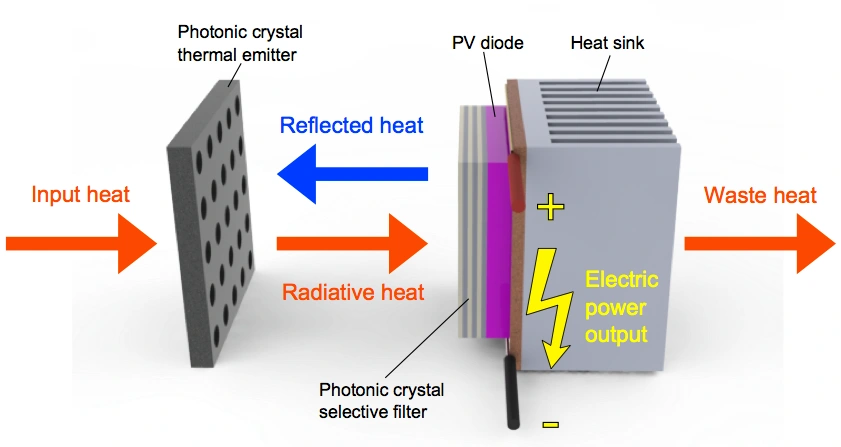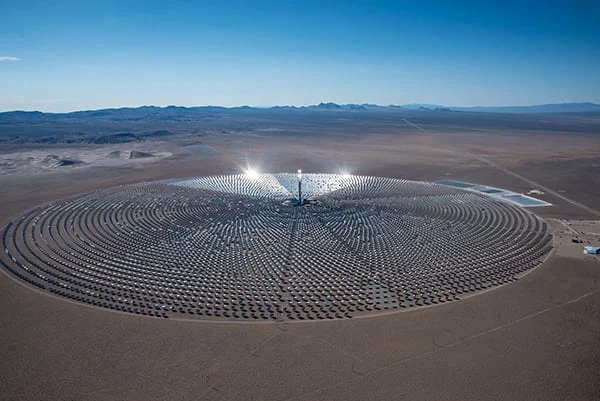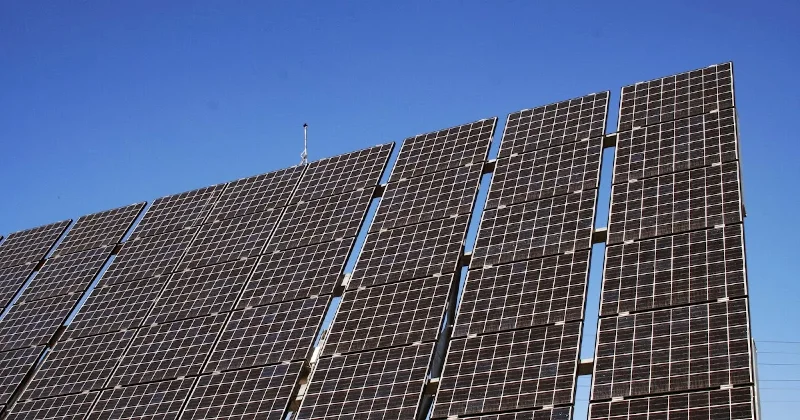In the ever-evolving landscape of renewable energy, solar and wind power have emerged as remarkably clean and cost-effective sources of electricity.
However, a significant hurdle remains on the path to widespread adoption of renewables: efficient energy storage.
To truly harness the potential of these green energy sources, we need a reliable and affordable method to store the energy they generate, enabling us to access it whenever and wherever needed.
Among various advancements in energy storage technologies, a recent breakthrough by researchers at the Massachusetts Institute of Technology (MIT) has caught the attention of the scientific community, offering a promising solution known as Thermophotovoltaics (TPVs).
TPVs, while grounded in established principles, bring a fresh perspective to energy storage.
But how does this cutting-edge technology function?
How does it compare to other existing energy storage methods?
And could TPVs potentially unlock the energy storage solution we have been eagerly anticipating?
Let’s delve into the intricate details of this revolutionary development.
Rethinking Energy Generation: Beyond Sunshine and Wind
Presently, a staggering 90% of the world’s electricity stems from heat-driven sources, including coal, natural gas, nuclear energy, and concentrated solar power.
For centuries, these methods have been reliant on steam turbines to convert heat into electricity. However, this approach poses several challenges.
Firstly, these systems involve intricate machinery that can be cumbersome to operate and maintain. More importantly, their efficiency is far from optimal.
In the realm of efficiency, the most advanced steam turbines achieve around 60%, yet the average efficiency hovers at a mere 35%.
A significant factor contributing to this inefficiency is the limited capacity of conventional turbines to handle high temperatures.
Temperatures exceeding 1500 degrees Celsius (2732 degrees Fahrenheit) lead to mechanical breakdowns within the machinery, resulting in a substantial waste of heat energy.
This inefficiency has spurred intense research into solid-state alternatives – heat engines devoid of moving parts that could operate efficiently at significantly elevated temperatures.
Enter thermophotovoltaics, or TPVs for short, a groundbreaking concept aiming to address these limitations and transform the energy storage landscape.
Thermophotovoltaics: Harnessing Heat for Unprecedented Efficiency
Thermophotovoltaics, despite its tongue-twisting name, encapsulates a remarkably elegant principle. Imagine traditional solar cells, but with a twist. Rather than converting solar radiation into electricity, TPV cells absorb thermal radiation emitted by a heat source.

This unique approach holds the key to a paradigm-shifting breakthrough, one that has been spearheaded by a team of MIT researchers under the leadership of Asegun Henry, an Associate Professor of Mechanical Engineering, in collaboration with the National Renewable Energy Lab.
This innovation comprises not one but two game-changing advancements. The first centers around an ingenious method of storing renewable energy.
The process begins by channeling surplus energy from wind or solar sources into a semiconducting material, such as tin, subsequently subjecting it to extreme temperatures surpassing 2,000 degrees Celsius (3,600 degrees Fahrenheit).
At this staggering heat, the tin transforms into a molten state, initiating a sequence that leads to the heart of the TPV concept.
The molten tin is then circulated through a sophisticated closed-loop system comprising carbon composite pipes. These pipes guide the superheated liquid into an insulated structure filled with massive graphite blocks.
The environment is enriched with argon gas, which acts as a protective shield, preventing oxidation and maintaining chemical stability. As the heat dissipates into the graphite blocks, it can be retained for prolonged durations.
The Marvel of Graphite: A Thermal Energy Reservoir
Graphite, with its exceptional heat-conducting properties, plays a pivotal role in this breakthrough. Its layered structure of carbon atoms and free electrons facilitates efficient heat transfer.
However, there’s more to the story.
Professor Henry highlights a fascinating principle: the rate at which heat escapes from an object is proportionate to its surface area, whereas the energy storage capacity corresponds to its volume.

This principle explains why a small cup of hot tea cools down rapidly, while larger objects, with their lower surface area-to-volume ratio, retain heat for extended periods.
The graphite blocks, spanning an area equivalent to half an American football field, epitomize this concept. Their formidable size-to-surface-area ratio ensures that they maintain heat for extended periods – a characteristic that aligns perfectly with the demands of efficient thermal energy storage.
Learning from Past Shortcomings: Engineering Innovation
Addressing the challenges encountered by previous energy storage technologies, the MIT researchers have employed innovative strategies to ensure TPVs’ success.
Drawing upon lessons from the Crescent Dunes solar plant in Nevada, which faced issues with high-temperature fluid leaks leading to operational setbacks, the MIT team devised a pioneering solution.

Their approach revolves around a carbon-based sealing mechanism that effectively contains the scorching liquid within the closed-loop system.
This breakthrough circumvents the leaks and stalls that plagued earlier attempts, providing a robust and efficient means of maintaining a stable and controlled thermal energy reservoir.
Harnessing the Power of Heat: Overcoming Challenges and Maximizing Efficiency
In the controlled environment of laboratory experiments, the MIT research team achieved an astonishing feat: the successful pumping of molten tin at temperatures surpassing 2000 degrees Celsius without encountering any leaks or operational glitches.
This achievement was so remarkable that it merited its own dedicated scientific paper – a testament to the significance of the accomplishment.
However, the true breakthrough lies not merely in the ability to transport superheated materials, but rather in the broader potential it unlocks.
Despite the promising strides taken in the lab, it’s important to approach this innovation with a degree of caution. The history of scientific advancements is peppered with instances where concepts that seemed groundbreaking faced setbacks or limitations when applied in real-world scenarios.
Even the tiles protecting spacecraft reentry vehicles often require replacement after just a few missions due to the harsh conditions they encounter.
Given that the TPV technology is still in its experimental phase, the resilience and durability of its components under practical conditions remain to be fully ascertained.
From Heat Storage to Power Extraction: The Role of TPV Cells
When the grid demands electrical power, a dynamic interplay unfolds within this innovative energy storage system.
Heat that has been meticulously stored within the graphite blocks is transferred to a separate building housing an array of large, hollow, rectangular chambers crafted from carbon-based materials and lined with tungsten foil.
The choice of tungsten is strategic: this material exhibits the ability to emit photons across a broad spectrum, spanning from high-energy ultraviolet to low-energy far-infrared.
The result is a rich emission of usable light that TPV cells can efficiently absorb and convert into electricity.
As the heat transfers to the tungsten-lined chambers, a fascinating visual phenomenon emerges: the tungsten begins to emit a brilliant white glow, reminiscent of the filament within a classic incandescent light bulb. These TPV cells are positioned within a compartment referred to as the Power Block.
Tailoring their exposure to the radiant light emitted by the glowing tungsten, the cells can be raised or lowered within the Power Block, adjusting their interaction with the light source to meet varying electricity demands.
However, while TPV cells share similarities with the solar panels found on residential rooftops, they also exhibit distinctive features that set them apart. The fundamental distinction lies in the materials utilized for their construction.
While conventional solar panels rely on silicon and are optimized to respond to specific wavelengths of light to generate electricity, TPV cells take a different route.
The MIT researchers opted for a material called gallium arsenide (GaN), the very same compound employed by NASA in their space-bound solar panels.
Gallium arsenide possesses a unique ability to efficiently absorb energy not only from sunlight but also from the light emitted by the radiant tungsten. This exceptional property positions GaN as a prime candidate for this groundbreaking energy storage system.
Furthermore, TPV cells distinguish themselves through their utilization of multiple gap junctions, a strategic design choice that overcomes limitations observed in traditional “single junction” photovoltaic cells.
The concept is ingeniously simple: the TPV cells incorporate over two dozen thin layers of diverse semiconductor materials, effectively creating two distinct cells stacked atop each other.
Each layer features a slightly different bandgap, enabling the capture of a wider spectrum of light. The top junction, with its higher bandgap, captures the most energetic photons from the heat source, specifically those in the visible part of the light spectrum around 800 nanometers.
In contrast, the lower junction is tailored to capture infrared light. By integrating these two junctions, TPV cells can harness an expansive spectrum of light, surpassing the capabilities of conventional solar cells.
Efficient Cooling for Endurance
The question naturally arises: how do these TPV cells endure the extreme temperatures they are subjected to?
The solution is a testament to innovative engineering.
The cells are securely affixed to the sides of a heat sink, a solid block of metal that incorporates intricate water channels. This configuration serves a dual purpose: it efficiently dissipates heat away from the cells, while the rapid flow of water ensures that the absorbed heat doesn’t transform the liquid into steam.
This ingenious cooling mechanism guarantees that the TPV cells remain operational and resilient even in the face of intense thermal stress.
As we continue our exploration, we will uncover the captivating potential of TPVs, their implications for energy storage, and the intricate web of innovation that shapes this revolutionary technology.
Optimizing Efficiency and Scaling Up: A Glimpse into the Future of TPV
While TPV cells exhibit the remarkable capability to absorb a broader spectrum of light when compared to their silicon counterparts, a substantial portion of light still manages to escape.
Recognizing the value of every iota of energy, the MIT research team strategically placed a highly reflective mirror at the base of each cell. This ingenious addition serves to redirect any residual light, which may have evaded capture, back through the TPV cell and into the tungsten material.
Here, the light is reabsorbed, bolstering the intensity of the tungsten’s glow. This dual benefit not only prevents energy wastage but also enhances luminescence, thereby augmenting voltage generation.
This innovative approach has led to the creation of solar cells that break records in terms of efficiency. The quality of the mirrored surface significantly influences the overall efficiency of the cell. The current mirrors employed by the research team boast an impressive maximum reflectivity of approximately 93%.
With this technology, the TPV cells have successfully converted about 41.1% of the energy emitted from the 2400-degree Celsius tungsten filament into usable electricity. This achievement represents a substantial leap beyond even the most advanced single-junction silicon cells available today.
And the story doesn’t end there – it gets even more exciting!
Professor Henry and his team have charted a well-defined path to achieve a staggering 98% reflectivity, a leap that could potentially yield an additional 10% increase in overall cell efficiency.
This trajectory could propel the TPV cells to achieve an unprecedented overall efficiency of 50%. The implications are staggering. If a 1 square meter TPV cell could attain this 50% efficiency, it could generate around 100 kilowatts of power.
To put this into perspective, a similarly sized conventional solar panel typically generates only about 300–400 watts, showcasing the immense energy output of tungsten when heated to an astounding 2400 degrees Celsius.
Visualize an array of TPV modules spanning 30 by 33 units, totaling approximately 990 square feet. This configuration would yield a remarkable total capacity of around 99,000 kilowatts, equivalent to nearly 100 megawatts.
Remarkably, the graphite blocks integral to the TPV system can retain enough heat to sustain power generation for approximately 10 hours. With an output of 100 megawatts per hour for this duration, such an array could yield a cumulative one gigawatt of energy – a staggering amount capable of powering tens of thousands of homes.
This incredible capacity, combined with the instantaneous energy delivery characteristic of TPV cells, positions them as an ideal solution for grid-scale applications.
Navigating Efficiency and Economics
While TPV cells demonstrate a remarkable efficiency of 50%, nearly double that of conventional silicon panels, it’s important to note that they still fall short of the efficiency achieved by certain energy storage systems, particularly lithium-ion batteries. Lithium-ion batteries, renowned for their efficiency, are capable of converting about 90% of stored energy back into electricity. However, despite their high efficiency, lithium-ion batteries face their own set of challenges, including expensive raw materials, complex supply chains, and overall cost.
The Energy Information Administration (EIA) indicates that the average capital cost for battery energy storage was around $589 per kilowatt-hour (kWh) in 2019, with lithium-ion technology hovering around $300 per kWh.
Professor Henry’s recent venture, Thermal Battery Corp., aims to revolutionize the energy storage landscape by significantly reducing costs. The team estimates that this innovative TPV system could achieve a remarkably low cost of approximately $10 per kWh of capacity – a dramatic cost reduction that holds the potential to reshape the economics of energy storage.
While gallium arsenide solar panels are traditionally more expensive than silicon counterparts, the intense light produced by the TPV cells fundamentally alters the cost-effectiveness equation.
More To Discover
- Tesla’s Fremont Factory Is Ignoring 112 Notices of Pollution Violations
- EU Shakes Up Eco-Market: Bans ‘Greenwashing’ in Landmark Environmental Legislation
- Heartworms and UV Hazards: Climate Change’s Toll on Pets and Polar Wildlife
- Vanuatu Stops Chinese Logging Firm Amid Theft Claims and Workers In Chinese Military Uniforms
A Promising Path Forward: The Potential of TPV
In the context of the vast cosmos, where the strength of sunlight diminishes with the square of distance, the concept of placing superheated tungsten in close proximity to TPV panels gains profound significance.
The resulting intensity of light emission becomes a driving force in this innovative energy storage system. The applicability and simplicity of installation are equally intriguing.
The vision of retrofitting decommissioned gas peaker plants with TPV storage systems emerges as a practical route for large-scale deployment.
A crucial advantage of this system is its modular nature. Each component operates independently, rendering the overall system adaptable and scalable to cater to the unique requirements of diverse grid systems.
The beauty of this approach lies in its flexibility: when additional storage capacity is needed, more graphite blocks can be seamlessly integrated; similarly, when a surge in energy demand arises, additional TPV cells can be introduced.
Thermal Battery Corp. is poised to mark a pivotal milestone by launching a 1 megawatt-hour pilot system by the end of 2022.
Ambitious plans for the future envision the implementation of a commercial-scale 50 megawatt-hour system by 2026. Notably, these projections are based on existing technology, leaving open the tantalizing possibility of even further enhancements.
The incorporation of graphene, which we’ve previously discussed in another context, could potentially elevate this groundbreaking technology to new heights.
As we contemplate the implications of TPV energy storage, the realm of possibilities expands. TPV could serve as the missing link in coupling with various heat storage sources, including innovations like the Finnish Sand Battery. These modular systems offer versatility in their configurations, adapting to diverse regions and natural resource availability.
Furthermore, the surplus heat produced by industrial processes, currently dissipating into the environment, might find new purpose by contributing to TPV systems positioned at power plants or smelters, thus boosting efficiency and harnessing otherwise lost energy.
Yet, amidst all this promise, it’s important to acknowledge the challenges that lie ahead.
The intricacies of managing and transferring heat, ensuring long-term cell durability, and navigating uncharted territory in terms of exposing gallium arsenide PV cells to such intense conditions remain hurdles to be overcome. The road to realizing the full potential of TPV energy storage requires rigorous research, development, and validation.
In conclusion, while the TPV breakthrough shines as a beacon of hope for efficient and cost-effective energy storage, its journey from lab innovation to real-world impact is rife with uncertainties and complexities. The world watches with anticipation as Thermal Battery Corp. continues to refine and prove the viability of this groundbreaking technology.
As we ponder the future of energy storage, TPV cells stand as a testament to human ingenuity, pushing the boundaries of what is possible and inching us closer to a sustainable and resilient energy future.


















